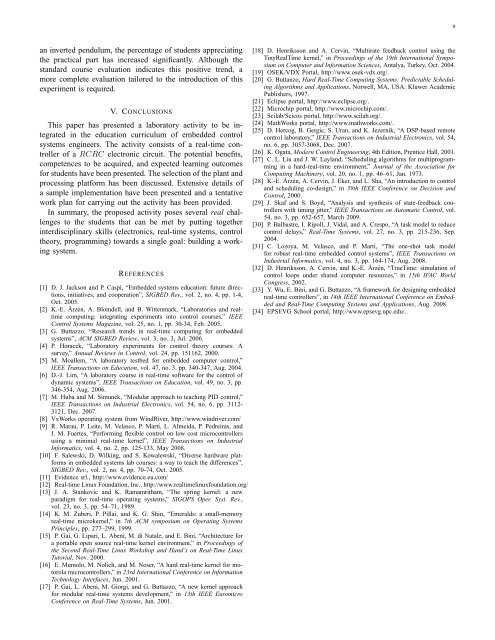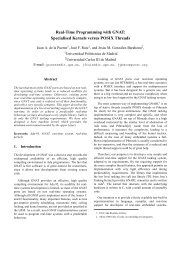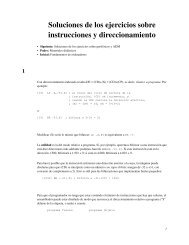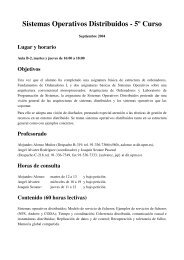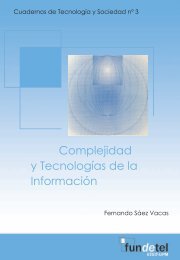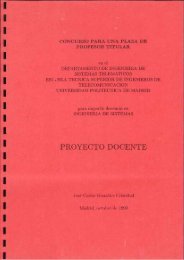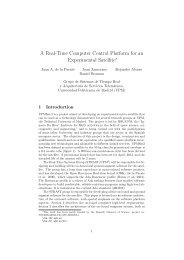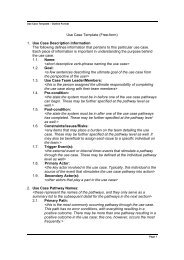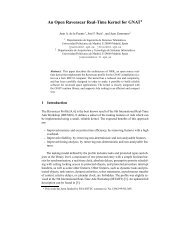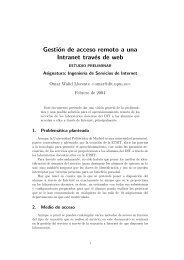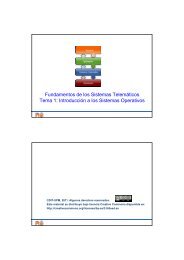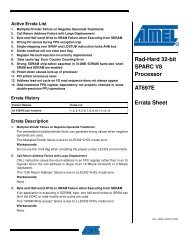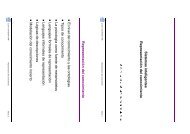Lab Proposal for Integrated Real-time and Control - DCS - UPC
Lab Proposal for Integrated Real-time and Control - DCS - UPC
Lab Proposal for Integrated Real-time and Control - DCS - UPC
You also want an ePaper? Increase the reach of your titles
YUMPU automatically turns print PDFs into web optimized ePapers that Google loves.
9an inverted pendulum, the percentage of students appreciatingthe practical part has increased significantly. Although thest<strong>and</strong>ard course evaluation indicates this positive trend, amore complete evaluation tailored to the introduction of thisexperiment is required.V. CONCLUSIONSThis paper has presented a laboratory activity to be integratedin the education curriculum of embedded controlsystems engineers. The activity consists of a real-<strong>time</strong> controllerof a RCRC electronic circuit. The potential benefits,competences to be acquired, <strong>and</strong> expected learning outcomes<strong>for</strong> students have been presented. The selection of the plant <strong>and</strong>processing plat<strong>for</strong>m has been discussed. Extensive details ofa sample implementation have been presented <strong>and</strong> a tentativework plan <strong>for</strong> carrying out the activity has been provided.In summary, the proposed activity poses several real challengesto the students that can be met by putting togetherinterdisciplinary skills (electronics, real-<strong>time</strong> systems, controltheory, programming) towards a single goal: building a workingsystem.REFERENCES[1] D. J. Jackson <strong>and</strong> P. Caspi, “Embedded systems education: future directions,initiatives, <strong>and</strong> cooperation”, SIGBED Rev., vol. 2, no. 4, pp. 1-4,Oct. 2005.[2] K.-E. Årzén, A. Blomdell, <strong>and</strong> B. Wittenmark, “<strong>Lab</strong>oratories <strong>and</strong> real<strong>time</strong>computing: integrating experiments into control courses,” IEEE<strong>Control</strong> Systems Magazine, vol. 25, no. 1, pp. 30-34, Feb. 2005.[3] G. Buttazzo, “Research trends in real-<strong>time</strong> computing <strong>for</strong> embeddedsystems”, ACM SIGBED Review, vol. 3, no. 3, Jul. 2006.[4] P. Horacek, “<strong>Lab</strong>oratory experiments <strong>for</strong> control theory courses: Asurvey,” Annual Reviews in <strong>Control</strong>, vol. 24, pp. 151162, 2000.[5] M. Moallem, “A laboratory testbed <strong>for</strong> embedded computer control,”IEEE Transactions on Education, vol. 47, no. 3, pp. 340-347, Aug. 2004.[6] D.-J. Lim, “A laboratory course in real-<strong>time</strong> software <strong>for</strong> the control ofdynamic systems”, IEEE Transactions on Education, vol. 49, no. 3, pp.346-354, Aug. 2006.[7] M. Huba <strong>and</strong> M. Simunek, “Modular approach to teaching PID control,”IEEE Transactions on Industrial Electronics, vol. 54, no. 6, pp. 3112-3121, Dec. 2007.[8] VxWorks operating system from WindRiver, http://www.windriver.com/[9] R. Marau, P. Leite, M. Velasco, P. Martí, L. Almeida, P. Pedreiras, <strong>and</strong>J. M. Fuertes, “Per<strong>for</strong>ming flexible control on low cost microcontrollersusing a minimal real-<strong>time</strong> kernel”, IEEE Transactions on IndustrialIn<strong>for</strong>matics, vol. 4, no. 2, pp. 125-133, May 2008.[10] F. Salewski, D. Wilking, <strong>and</strong> S. Kowalewski, “Diverse hardware plat<strong>for</strong>msin embedded systems lab courses: a way to teach the differences”,SIGBED Rev., vol. 2, no. 4, pp. 70-74, Oct. 2005.[11] Evidence srl., http://www.evidence.eu.com/[12] <strong>Real</strong>-<strong>time</strong> Linux Foundation, Inc., http://www.real<strong>time</strong>linuxfoundation.org/[13] J. A. Stankovic <strong>and</strong> K. Ramamritham, “The spring kernel: a newparadigm <strong>for</strong> real-<strong>time</strong> operating systems,” SIGOPS Oper. Syst. Rev.,vol. 23, no. 3, pp. 54–71, 1989.[14] K. M. Zuberi, P. Pillai, <strong>and</strong> K. G. Shin, “Emeralds: a small-memoryreal-<strong>time</strong> microkernel,” in 7th ACM symposium on Operating SystemsPrinciples, pp. 277–299, 1999.[15] P. Gai, G. Lipari, L. Abeni, M. di Natale, <strong>and</strong> E. Bini, “Architecture <strong>for</strong>a portable open source real-<strong>time</strong> kernel environment,” in Proceedings ofthe Second <strong>Real</strong>-Time Linux Workshop <strong>and</strong> H<strong>and</strong>’s on <strong>Real</strong>-Time LinuxTutorial, Nov. 2000.[16] E. Mumolo, M. Nolich, <strong>and</strong> M. Noser, “A hard real-<strong>time</strong> kernel <strong>for</strong> motorolamicrocontrollers,” in 23rd International Conference on In<strong>for</strong>mationTechnology Interfaces, Jun. 2001.[17] P. Gai, L. Abeni, M. Giorgi, <strong>and</strong> G. Buttazzo, “A new kernel approach<strong>for</strong> modular real-<strong>time</strong> systems development,” in 13th IEEE EuromicroConference on <strong>Real</strong>-Time Systems, Jun. 2001.[18] D. Henriksson <strong>and</strong> A. Cervin, “Multirate feedback control using theTiny<strong>Real</strong>Time kernel,” in Proceedings of the 19th International Symposiumon Computer <strong>and</strong> In<strong>for</strong>mation Sciences, Antalya, Turkey, Oct. 2004.[19] OSEK/VDX Portal, http://www.osek-vdx.org/.[20] G. Buttanzo, Hard <strong>Real</strong>-Time Computing Systems: Predictable SchedulingAlgorithms <strong>and</strong> Applications, Norwell, MA, USA: Kluwer AcademicPublishers, 1997.[21] Eclipse portal, http://www.eclipse.org/.[22] Microchip portal, http://www.microchip.com/.[23] Scilab/Scicos portal, http://www.scilab.org/.[24] MathWorks portal, http://www.mathworks.com/.[25] D. Hercog, B. Gergic, S. Uran, <strong>and</strong> K. Jezernik, “A DSP-based remotecontrol laboratory,” IEEE Transactions on Industrial Electronics, vol. 54,no. 6, pp. 3057-3068, Dec. 2007.[26] K. Ogata, Modern <strong>Control</strong> Engineering, 4th Edition, Prentice Hall, 2001.[27] C. L. Liu <strong>and</strong> J. W. Layl<strong>and</strong>, “Scheduling algorithms <strong>for</strong> multiprogrammingin a hard-real-<strong>time</strong> environment,” Journal of the Association <strong>for</strong>Computing Machinery, vol. 20, no. 1, pp. 46–61, Jan. 1973.[28] K.-E. Årzén, A. Cervin, J. Eker, <strong>and</strong> L. Sha, “An introduction to control<strong>and</strong> scheduling co-design,” in 39th IEEE Conference on Decision <strong>and</strong><strong>Control</strong>, 2000.[29] J. Skaf <strong>and</strong> S. Boyd, “Analysis <strong>and</strong> synthesis of state-feedback controllerswith timing jitter,” IEEE Transactions on Automatic <strong>Control</strong>, vol.54, no. 3, pp. 652-657, March 2009.[30] P. Balbastre, I. Ripoll, J. Vidal, <strong>and</strong> A. Crespo, “A task model to reducecontrol delays,” <strong>Real</strong>-Time Systems, vol. 27, no. 3, pp. 215-236, Sep.2004.[31] C. Lozoya, M. Velasco, <strong>and</strong> P. Martí, “The one-shot task model<strong>for</strong> robust real-<strong>time</strong> embedded control systems”, IEEE Transactions onIndustrial In<strong>for</strong>matics, vol. 4, no. 3, pp. 164-174, Aug. 2008.[32] D. Henriksson, A. Cervin, <strong>and</strong> K.-E. Årzén, “TrueTime: simulation ofcontrol loops under shared computer resources,” in 15th IFAC WorldCongress, 2002.[33] Y. Wu, E. Bini, <strong>and</strong> G. Buttazzo, “A framework <strong>for</strong> designing embeddedreal-<strong>time</strong> controllers”, in 14th IEEE International Conference on Embedded<strong>and</strong> <strong>Real</strong>-Time Computing Systems <strong>and</strong> Applications, Aug. 2008.[34] EPSEVG School portal, http://www.epsevg.upc.edu/.


